糖酸含量和种类是影响梨果实品质和口味的重要因素[1],也是品种特性的重要参数之一[2]。研究表明梨果实的可溶性糖主要为果糖、葡萄糖、蔗糖和山梨醇[3],这些糖也是果实品质成分和风味物质合成的基础物质[4]。有研究对丰水等6 个砂梨品种的糖分析表明,果实中4 种主要可溶性糖平均含量由高到低排序为果糖>山梨醇>葡萄糖>蔗糖[5]。每种糖的甜度和口感不同,不同品种的果实可溶性糖含量及组成的不同而形成不同的甜味口感。梨果实的品质不仅仅取决于可溶性糖含量,适宜的糖酸比也是重要的。适量的有机酸使果实具有清爽的感觉,特别是在含糖量较高时,更易产生宜人的口感。相对于可溶性糖,果实中的有机酸绝对含量较低。梨果实中的有机酸主要是苹果酸、柠檬酸、琥珀酸、莽草酸、酒石酸、奎宁酸、乳酸、富马酸等[6]。段敏杰等[5]利用HPLC 测定了6 个砂梨品种的有机酸组分和含量,各组分含量平均值由高到低依次为苹果酸>柠檬酸>奎宁酸>草酸>莽草酸>乳酸>富马酸>马来酸。苹果酸和柠檬酸是2 种主要的有机酸,与果实酸度有显著的相关性。
鲁秀梨是青岛农业大学以黄金梨为母本、砀山酥梨为父本杂交育成。果皮褐色,果形正,自花授粉结实率高、丰产性好,成熟果实中可溶性固形物含量高,在青岛地区8 月中旬成熟。鲁秀梨是一个酸甜适口、风味浓郁的砂梨新品种,给人一种甜而不腻的感觉,特别受年轻消费者的喜爱。但是,如果采收时间不当,就会出现酸味偏重等问题。因此笔者采用高效液相色谱法,系统研究了鲁秀梨果实生长发育中后期及贮藏期间的糖酸组分及含量变化,以明确鲁秀梨果实中糖酸累积的变化规律,为鲁秀优质果品生产、果实的适时采收和适时供应市场消费提供依据。
1 材料和方法
1.1 材料
鲁秀梨[P.pyrifolia(Burm.f.)Nakai‘Luxiu’]种植于青岛农业大学胶州现代农业示范园,砧木为豆梨(P.calleryana Decne.),株行距为1.5 m×4 m,2012年定植,为小冠疏散分层形,树势健壮一致,常规管理。
1.2 方法
1.2.1 样品采集与制备 根据果实发育的时间,分别选取了花后80、100和120 d(采收时间)进行样品采集。采集时选取有代表性的树,在每株树冠外围不同方向(各树采果部位一致)选取3个有代表性的果实用于指标测定,每3 株树为1 个重复,3 次重复。将果实按果皮、果肉和近果心部位分别取样,分别切碎混匀,每个样品准确称取2.000 g,用铝箔纸包好、液氮中速冻后,放入-80 ℃中保存。其中果皮取材是用削皮机削取果胴部果皮组织(宽度为20~30 mm,皮厚为0.5~1.0 mm),之后向果心方向切取10 mm 为果肉组织,由果心线向果皮方向切取10 mm为近果心部位。
采收的果实当天运回,放在16 ℃温度下进行预冷和挑选,之后入1 ℃冷库中贮藏,入库当天为0 d,之后每隔30 d取样1次,取果肉部分进行测定,样品处理同上。
1.2.2 可溶性糖和有机酸含量测定 参考高海燕等[7]的方法并加以改良。取保存的样品2 g,加5 mL 80%乙醇提取液,涡旋混匀,37 ℃水浴30 min,超声波提取15 min,离心(4 ℃,12 000 g,15 min),取上清液,重复提取3次。合并3次上清液,定容至25 mL。取2 mL 溶液用旋转蒸发仪蒸干,加1 mL 纯水溶解后,过C18SPE 固相萃取小柱除去溶液中的较大颗粒,再经0.22 μm滤膜过滤3次后用于上机测定。测定用的高效液相色谱仪为安捷伦1100型。
可溶性糖含量的测定采用Hi-Plex 碳水化合物柱;柱温85 ℃,参比池温度35 ℃。流动相为脱气后的超纯水(18.2 MΩ·cm),流速0.6 mL·min-1。采用G1362ARID示差折光检测器,进样量10 μL,根据测得的样品峰面积和各种糖的标准曲线计算其含量(以鲜质量计)。
有机酸含量测定采用Zorbar SB-Aq 色谱柱(4.6 mm×250 mm,5 μm),柱温35 ℃,流动相为磷酸氢二钾缓冲液(pH 3.0),流速0.6 mL·min-1。采用SPD-10Avp 紫外折光检测器,波长为210 nm,进样量10 μL,根据测得的样品峰面积和各种酸的标准曲线计算其含量(以鲜质量计)。
1.3 数据分析
采用SPSS 17.0进行数据处理和分析。
2 结果与分析
2.1 鲁秀梨果实可溶性糖含量的变化
2.1.1 鲁秀梨果实生长期不同部位可溶性糖含量的变化 随梨果实生长发育可溶性总糖含量变化如图1所示。所测的果实各部位的可溶性总糖含量在花后80~120 d 采收时都是逐渐增加的,到采收时果肉和近果心部可溶性总糖含量相近,明显高于果皮。但果肉组织可溶性总糖累积到最大量的速度明显高于近果心部,高于果皮。
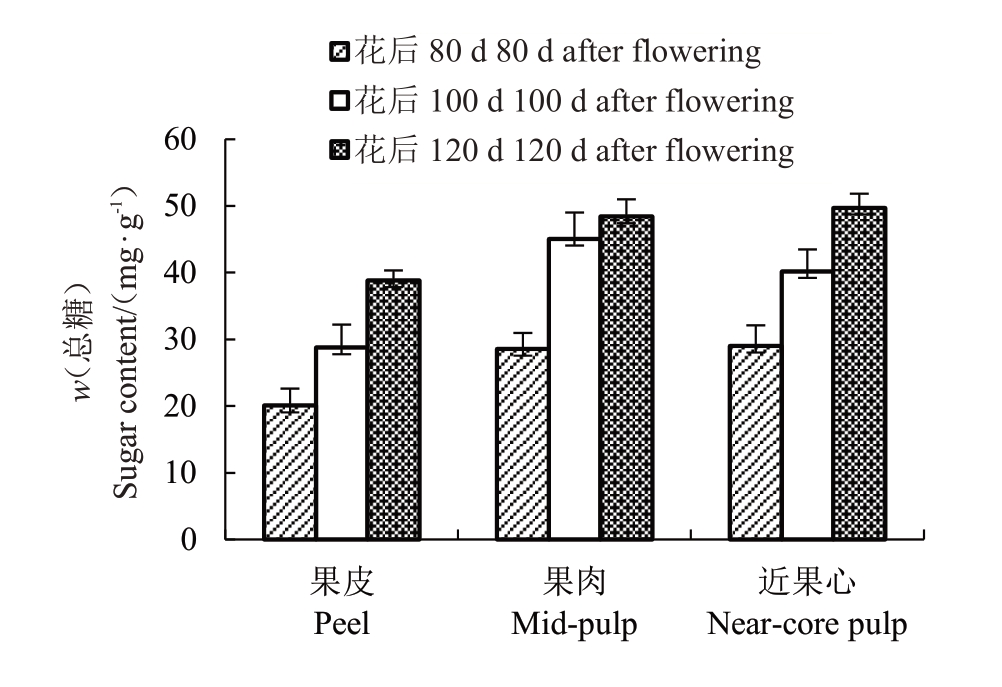
图1 鲁秀梨果实生长发育中后期不同部位可溶性总糖含量的变化
Fig.1 Changes of total sugar content in different parts of Luxiu pear fruit development in the mid to late period
由图2 可以看出,鲁秀梨果实不同部位糖组分含量和变化趋势有所不同,总糖的变化与各组分的消长变化有关。果皮和近果心部位的果糖含量在花后80~120 d 采收时都呈增加趋势,而果肉部位果糖含量在花后100 d 时最高,在花后120 d 时果糖含量有所下降(图2-A)。葡萄糖含量在花后80~120 d采收时呈现先上升后下降的趋势;果实果肉与近果心部位的葡萄糖含量高于果皮部位(图2-B)。蔗糖含量花后100 d 前较少,之后急剧增加,果肉与近果心部位的蔗糖含量高于果皮部位(图2-C)。花后80~120 d 采收时,山梨醇含量的变化是趋于平稳的,不同部位之间的差异也不明显(p >0.05)(图2-D)。
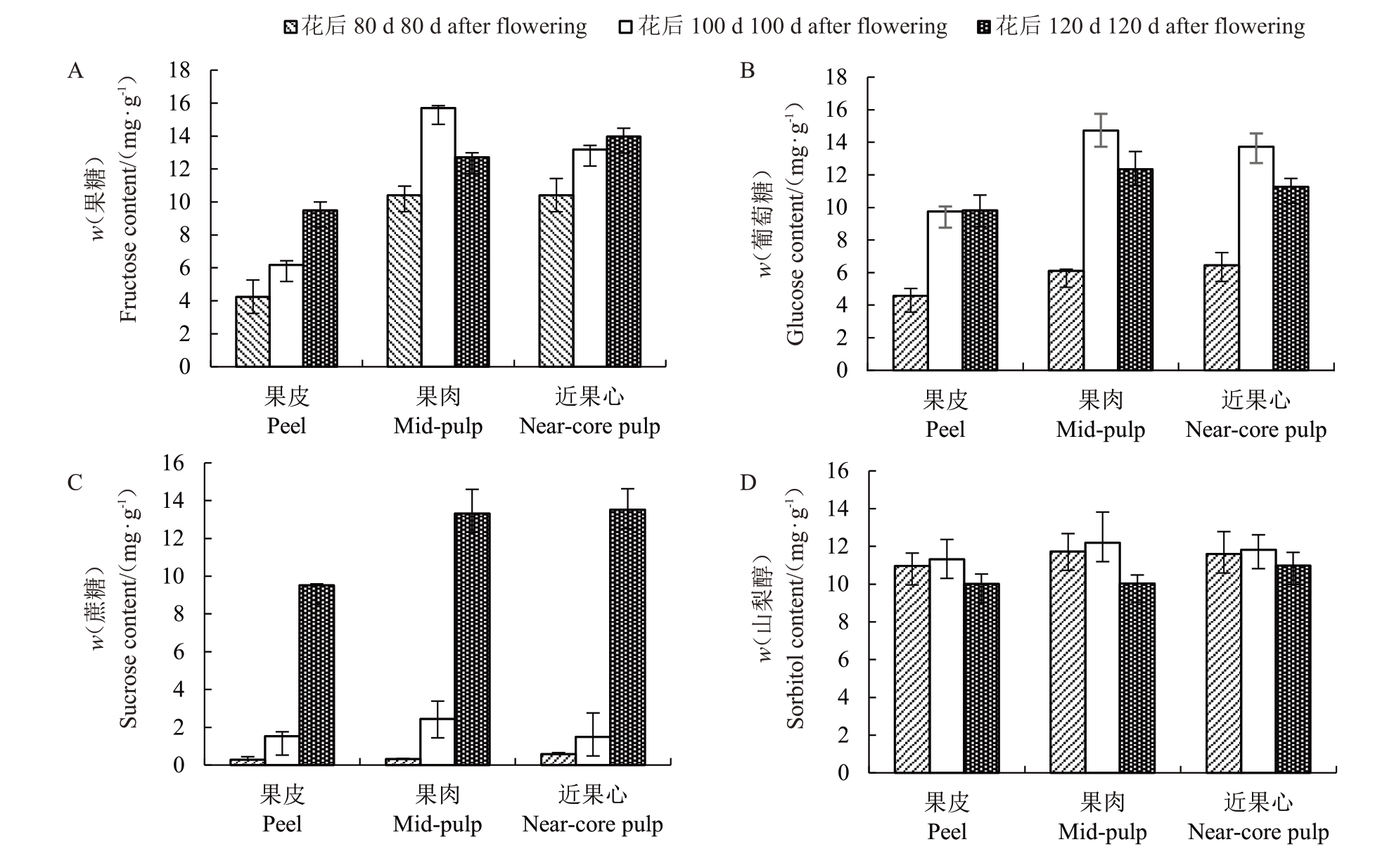
图2 鲁秀梨果实生长发育中后期不同部位可溶性糖含量的变化
Fig.2 Changes of soluble sugar content in different parts of Luxiu pear development in the mid to late period
2.1.2 鲁秀梨果实贮藏期可溶性糖含量的变化 鲁秀梨果实采收后随着贮藏时间延长可溶性总糖含量变化如图3,在贮藏期间(0~180 d)总糖含量整体呈先上升后下降趋势,在贮藏30 d 时可溶性总糖含量最高。
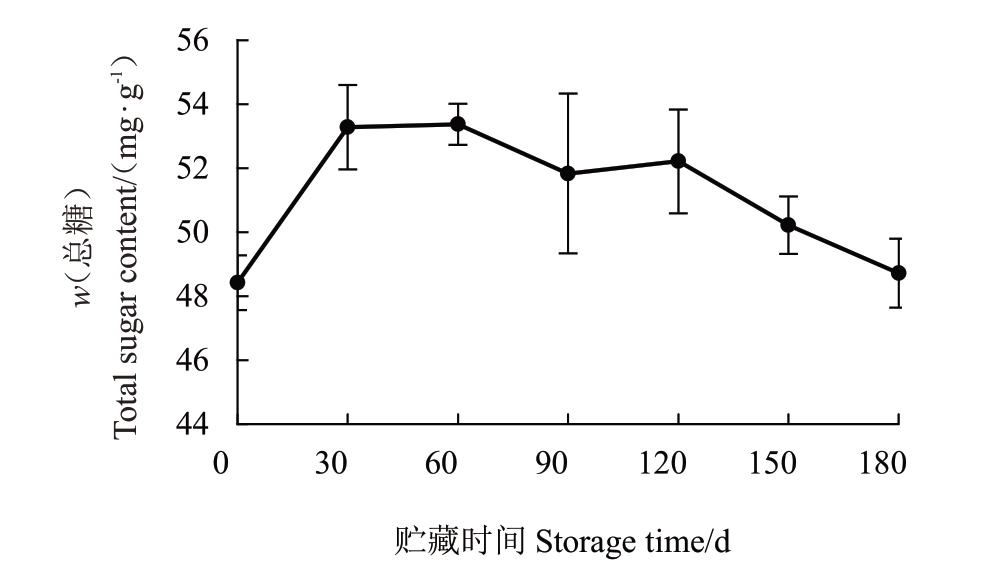
图3 贮藏期间鲁秀梨果实总糖含量的变化
Fig.3 Changes of total sugar contents in Luxiu pear during storage
其中,果糖和葡萄糖含量在梨果实贮藏期间的变化趋势相同(图4-A~B),均是先下降,在贮藏60 d时下降到最低,之后上升,到贮藏期后期再次下降。蔗糖含量的变化趋势与这三者不同,采后是一直增加的,在60 d 时达到最高,之后快速下降,贮藏90 d后平稳下降(图4-C)。山梨醇含量变化与前者相似,仅在贮藏30 d时较0 d有所增加(图4-D)。

图4 贮藏期间鲁秀梨果实可溶性糖含量的变化
Fig.4 Changes of soluble sugar content in Luxiu pear during storage
2.2 鲁秀梨果实有机酸含量的变化
2.2.1 鲁秀梨果实生长期有机酸含量的变化 鲁秀梨果实发育期的有机酸含量变化如图5所示。果实不同部位的有机酸含量不同,整个测试期间,果皮部位有机酸含量低于果肉和近果心部位,后二者相似。有机酸含量随着果实成熟逐渐下降,果肉和近果心部位在花后100 d时下降幅度较大,之后至采收时变化不明显,而果皮部位在花后80~100 d 变化较小,在120 d时急剧下降。
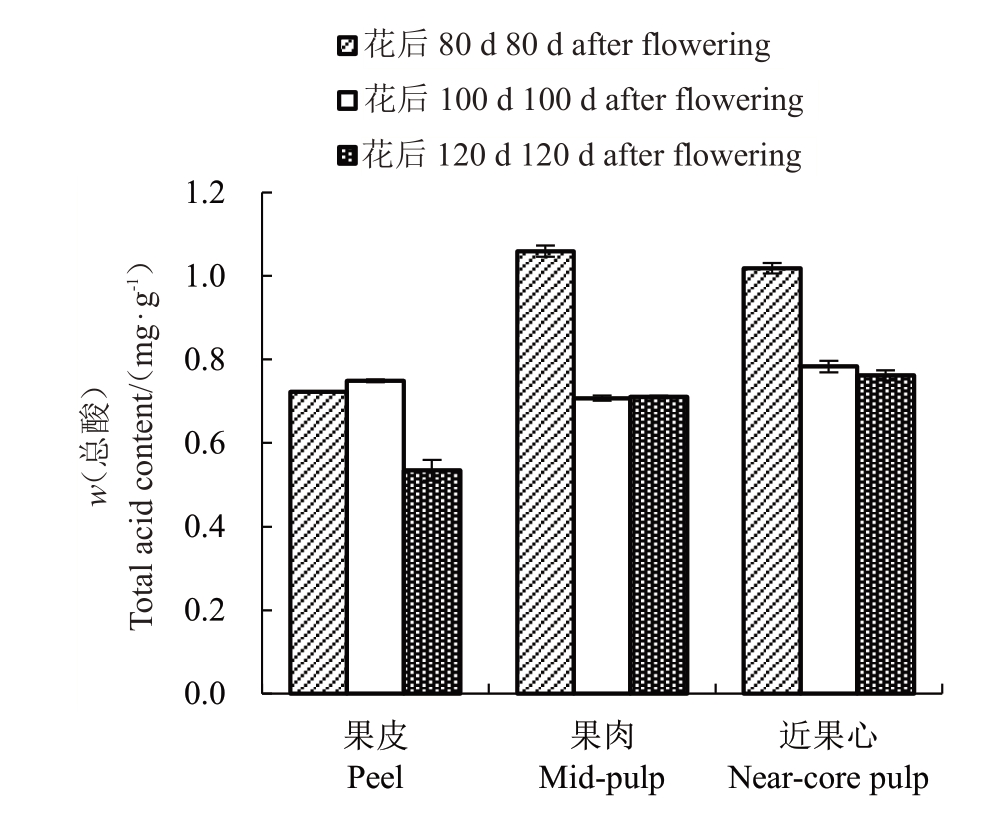
图5 鲁秀梨果实生长发育中后期不同部位总酸含量的变化
Fig.5 Changes of total organic acid content in different parts of Luxiu pear fruit development in the mid to late period
对主要有机酸组成成分测定的结果(图6)表明,在花后80~120 d,苹果酸、奎宁酸、酒石酸和莽草酸含量逐渐降低,与果实中总酸含量的变化趋势是一致的(图6-A~B,D~E);而柠檬酸含量变化与之不同,是逐渐上升的(图6-C),草酸含量变化不明显(图6-F)。图6结果也表明,果实各部分有机酸组成不同。在花后120 d采收时,苹果酸含量在果肉与近果心部位相似,显著高于果皮(图6-A~D),而奎宁酸和酒石酸含量从果皮到近果心部位依次降低,果皮中的含量显著高于果肉和果心部位(图6-B)。柠檬酸含量则是从果皮到近果心部位依次增加,近果心部位显著高于果肉,果肉也显著高于果皮(图6-C)。莽草酸和草酸含量在果实采收时各部位的分布与苹果酸相似,但是含量较低(图6-E~F)。

图6 鲁秀梨果实生长中后期不同部位有机酸含量的变化
Fig.6 Changes of total organic acid content in different parts of Luxiu pear development in the mid to late period
2.2.2 鲁秀梨果实贮藏期有机酸含量的变化 在贮藏期鲁秀梨果实有机酸含量变化如图7 所示,呈先下降后稳定趋势;在贮藏60 d 时,有机酸含量最低,之后随着贮藏期延长,有机酸含量轻微上升后趋于稳定。
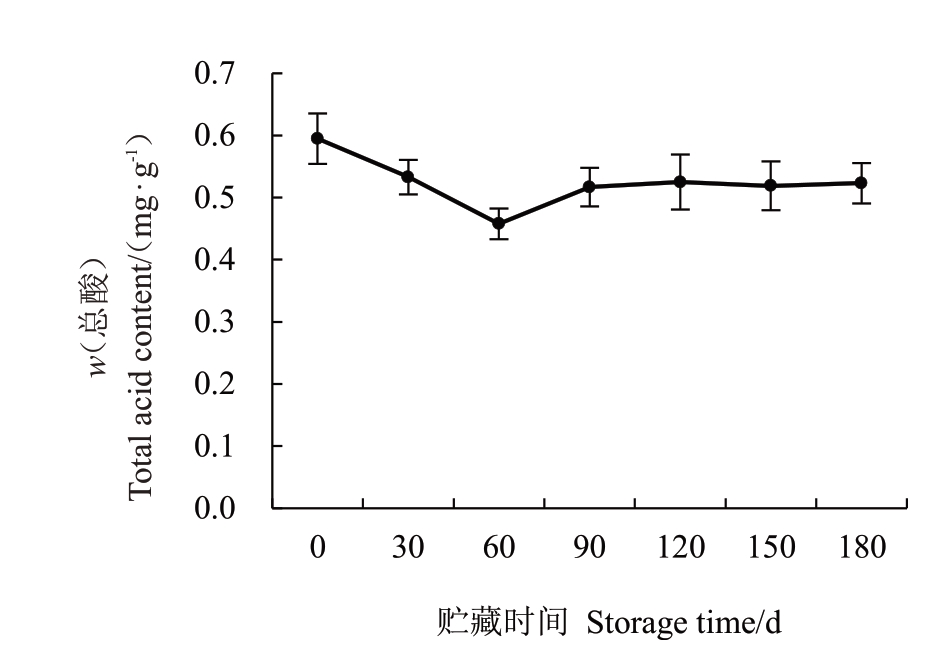
图7 贮藏期间鲁秀梨果实总酸含量的变化
Fig.7 Changes of organic acid contents in Luxiu pear during storage
由图8可以看出,贮藏期间,苹果酸与草酸含量的变化趋势一致,均呈先下降后缓慢上升趋势;苹果酸在贮藏60 d 时含量最低,草酸在贮藏至30 d 时含量为最低,之后随着贮藏期的延长,两者含量缓慢上升(图8-A,F)。柠檬酸、奎宁酸和莽草酸含量在贮藏期的变化不明显(图8-B,C,E)。酒石酸含量在贮藏前30 d明显升高,贮藏60 d时含量降至最低,之后随着贮藏期延长,酒石酸含量明显增加(图8-D)。
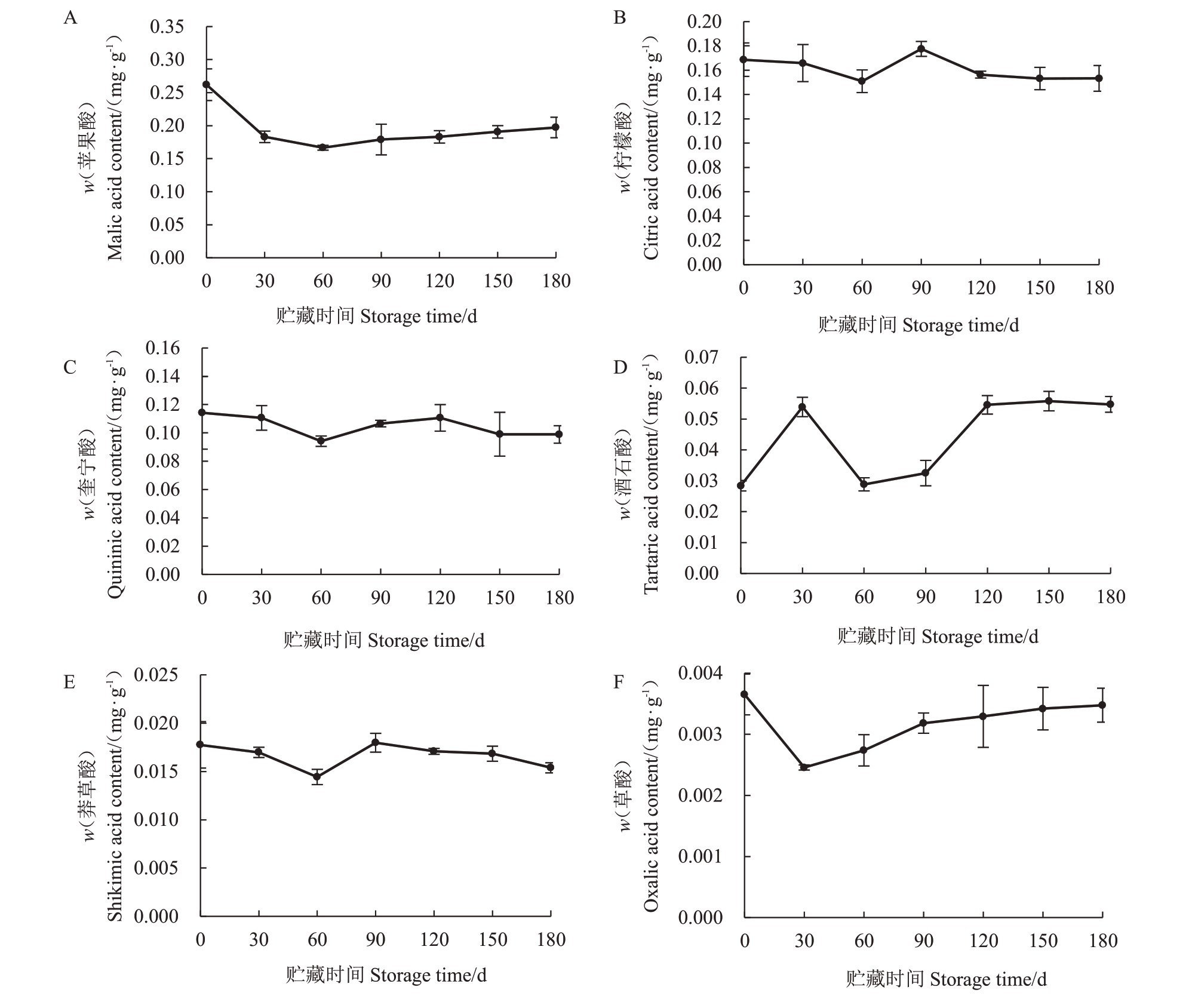
图8 贮藏期间鲁秀梨果实有机酸含量的变化
Fig.8 Changes of total organic acid contents in Luxiu pear during storage
3 讨 论
梨果实的可溶性糖主要为果糖、葡萄糖、蔗糖和山梨醇[3],不同种类的糖其甜度和口感不同,果糖最甜,蔗糖次之,葡萄糖甜度最低,这3 种糖的甜度比值分别为1.75、1.00 和0.75[8]。果糖与其他糖相比,在口中的甜味感来得快,消失也快。蔗糖的口感来得慢,去得也慢,在口中甜味要30 s后才消失。山梨醇属于糖醇类,是梨属植物主要的光合产物,也是梨糖运输的主要形式,因此山梨醇也是梨果实中重要的糖组分,其甜度为蔗糖的一半,与改善果实的甜度也有关[9-10]。不同的果实由于糖的组成和含量不同形成不同的甜味口感。通过提高果实的总糖水平或者通过增加果糖的积累来提高果糖的比值,可提高果实的甜度及品质[11]。有研究表明,果实发育过程中蔗糖积累与成熟果实中可溶性糖水平有直接关系[12],蔗糖含量变化将直接影响可溶性糖含量,蔗糖含量的变化也可能是不同品种间差异的主要原因[13]。因此,也可通过提高果实发育中的蔗糖积累水平来提高成熟果实总糖水平,改善果实甜度[10]。本试验中发现鲁秀梨果实中果糖和葡萄糖含量在测定的前期含量较高,在花后100 d 时达到高峰;而蔗糖在花后100 d 之后快速累积,在成熟时,其在总糖中所占比例明显增加。在风味浓郁的南果梨上也有报道,在果实发育前期及中期几乎不含蔗糖,仅在采收前期急剧累积[14]。这可能是由于果实生长发育期,山梨醇是同化物运输主要形式[15-16],由叶片转运到果实的山梨醇大部分转化合成为果糖和葡萄糖,蔗糖合成量相对较小,而进入果实膨大期和成熟期,转运到果实的山梨醇在转化合成葡萄糖和果糖之后,同时迅速转化合成蔗糖,致使蔗糖含量快速增加[17]。可能由于成熟时蔗糖总量和在总糖中的比例增加,果糖和蔗糖甜味感特性互补,得以持久厚重。山梨醇在本试验中整个测定期间含量变化很小,本身甜度低,对果实风味变化影响较小。梨是典型的呼吸跃变型果实,在整个贮藏期间,梨果实中的可溶性固形物、糖含量均呈先上升后下降趋势[18]。本试验中,鲁秀梨果实采后可溶性总糖含量在贮藏至30 d时依旧呈上升趋势,但随着贮藏时间延长逐渐降低,说明在一般贮藏条件下,不宜贮藏时间过长。
梨果的风味不仅仅与甜味有关,有机酸含量对于平衡果实的风味非常重要,即适宜的糖酸比有利于改善口感。酸含量过高会影响果实的适口性,而过低会使果实显得平淡无味[19]。大部分梨果实在成熟时以一种或两种有机酸为主,其他有机酸则以少量甚至是微量存在[20-21]。本研究中,鲁秀梨果实在发育中期主要以苹果酸和奎宁酸为主,在成熟时则以苹果酸和柠檬酸为主。有机总酸含量是随着果实生长、成熟而降低的。其中柠檬酸含量随着果实生长发育升高,但是含量水平一直低于苹果酸,这与Hudina 等[22]和徐文清[23]研究报道一致。适量的苹果酸具有清爽的感觉,酸味持续时间长,回味较长。浓度过高则显尖酸的感觉和青生味。柠檬酸的口感先于苹果酸,且比苹果酸能达到更高的酸度,酸性持续的时间短[24]。由于不同砂梨品种的苹果酸和柠檬酸含量不同,口感不同,据此将梨品种分为苹果酸型和柠檬酸型2 类[25]。从整个生长发育和贮藏期来看,鲁秀梨果实中苹果酸含量都是高于柠檬酸含量,为苹果酸优势型果实。苹果酸刚好与蔗糖的口感反应类似,从而形成鲁秀先甜后酸甜并持久厚重、风味浓而爽的特点。果实采收后,有机酸含量在贮藏至60 d时一直呈下降趋势。因此,贮藏改变了果实的糖酸比,改变了果实的口感风味。
李树玲等[26]探讨了糖酸比与果实风味的关系,比值<15.0 的果实风味多为甜酸或酸涩;比值在15.1~25.0的果实风味多甜酸;比值为25.1~60.0的果实风味多酸甜;比值>60.1的果实风味多为淡甜,甜或甘甜。鲁秀梨果实在花后80 d 时糖酸比为26.9,花后100 d 糖酸比为63.7,花后120 d 时糖酸比为68.1,随着果实生长发育,糖酸比逐渐增加;采后贮藏期,随着贮藏时间增加,糖含量先增加后降低,有机酸含量先降低后增加,糖酸比先增加后降低,最高达到116.60。这可能是鲁秀梨果实冷藏后口感更甜的原因。
4 结 论
鲁秀梨果实可溶性糖主要由果糖、葡萄糖、蔗糖和山梨醇组成。可溶性糖含量是随着果实发育和成熟而增加,在花后100 d之前的增加是由于果糖和葡萄糖累积增加,之后的增加则主要是由于蔗糖在成熟前的快速累积。山梨醇含量在整个测定时间变化幅度较小。采后贮藏期间可溶性糖有一个继续增加期。果实的有机酸主要由苹果酸、柠檬酸、酒石酸、奎宁酸组成,苹果酸含量始终高于柠檬酸含量,并与总酸变化一致,随着成熟而下降,为苹果酸优势型果实。果糖、蔗糖和苹果酸可能是鲁秀梨果实特有风味的主要贡献因子。可溶性糖和有机酸含量及比值可以作为鲁秀果实采收与销售的参考指标。
通过计算不同时期果实的糖酸比值,表明鲁秀梨果实在花后120 d 时采收最为适宜,采收后贮藏60 d内可溶性总糖含量最高、有机酸含量最低,可食用性好,为最佳销售期。
[1] 蒋爽,岳晓燕,滕元文,王晓庆,施春晖,徐芳杰,张学英,白松龄,骆军.不同砂梨果实中糖酸含量及代谢相关基因表达分析[J].果树学报,2016,33(S1):65-70.JIANG Shuang,YUE Xiaoyan,TENG Yuanwen,WANG Xiaoqing,SHI Chunhui,XU Fangjie,ZHANG Xueying,BAI Songling,LUO Jun. The contents of sugars and acids,and the expression analysis of metabolism-associated genes in fruit of Pyrus pyrifolia[J].Journal of Fruit Science,2016,33(S1):65-70.
[2] 姚改芳,张绍铃,吴俊,曹玉芬,刘军,韩凯,杨志军.10 个不同系统梨品种的可溶性糖与有机酸组分含量分析[J].南京农业大学学报,2011,34(5):25-31.YAO Gaifang,ZHANG Shaoling,WU Jun,CAO Yufen,LIU Jun,HAN Kai,YANG Zhijun.Analysis of components and contents of soluble sugars and organic acids in ten cultivars of pear by high performance liquid chromatography[J]. Journal of Nanjing Agricultural University,2011,34(5):25-31.
[3] 吴昌琦,贾璐婷,樊进补,张臻,马敏,张苏铃,刘志强,任雅倩,王利斌,张绍铃.园艺作物果实糖酸转化研究进展[J].中国果菜,2020,40(11):39-47.WU Changqi,JIA Luting,FAN Jinbu,ZHANG Zhen,MA Min,ZHANG Suling,LIU Zhiqiang,REN Yaqian,WANG Libin,ZHANG Shaoling.Research progress of sugar and acid transformation in horticultural fruits[J]. China Fruit &Vegetable,2020,40(11):39-47.
[4] PANGBOM R M. Relative taste intensities of selected sugars and organic acids[J].Journal of Food Science,1963,28(6):726-733.
[5] 段敏杰,伊洪伟,杨丽,武峥,王进.不同砂梨品种果实糖酸组分及含量分析[J].南方农业学报,2020,51(9):2236-2244.DUAN Minjie,YI Hongwei,YANG Li,WU Zheng,WANG Jin.Sugar and acid compositions and their contents in different Pyrus pyrifolia varieties[J].Journal of Southern Agriculture,2020,51(9):2236-2244.
[6] ESTI M,MESSIA M C,SINESIO F,NICOTRA A,CONTE L,NOTTE E L,PALLESCHI G.Quality evaluation of peaches and nectarines by electrochemical and multivariate analysis:relationships between analytical measurements and sensory attributes[J].Food Chemistry,1997,60(4):659-666.
[7] 高海燕,王善广,胡小松.利用反相高效液相色谱法测定梨汁中有机酸的种类和含量[J].食品与发酵工业,2004,30(8):96-100.GAO Haiyan,WANG Shanguang,HU Xiaosong.Study on determination of kinds and contents of organic acids in pear juice by high performance Liquid Chromatography[J].Food and Fermentation Industries,2004,30(8):96-100.
[8] DORY T E. Fructose sweetness:a new dimension[J]. Cereal Foods World,1976,21:62-63.
[9] 周睿,束怀瑞.高等植物中的山梨醇及其代谢[J].植物生理学通讯,1993,29(5):384-390.ZHOU Rui,SHU Huairui. Sorbitol and its metabolism in higher plants[J].Plant Physiology Journal,1993,29(5):384-390.
[10] BERUTER J,FEUSI M E S,RUEDI P.Sorbitol and sucrose partitioning in the growing apple fruit[J].Journal of Plant Physiology,1997,151(3):269-276.
[11] 秦巧平,张上隆,谢鸣,陈俊伟.果实糖含量及成分调控的分子生物学研究进展[J].果树学报,2005,22(5):519-525.QIN Qiaoping,ZHANG Shanglong,XIE Ming,CHEN Junwei.Progress on the research of the molecular regulation of sugar content and composition in fruit[J]. Journal of Fruit Science,2005,22(5):519-525.
[12] SCHAFFER A A,PETREIKOV M,MIRON D,FOGELMAN M,CHEN L. Modification of carbohydrate content in developing tomato fruit[J].Hortscience,1997,34(6):1024-1027.
[13] 姚改芳. 不同栽培种梨果实糖酸含量特征及形成规律研究[D].南京:南京农业大学,2011.YAO Gaifang. Study on the characteristics and formation rules of sugar acid content in pear fruits of different cultivars[D].Nanjing:Nanjing Agricultural University,2011.
[14] 于年文,李俊才,郭修武,王家珍,蔡忠民,沙守峰,李宏军.南果梨果实糖、酸变化规律[J]. 西北农业学报,2010,19(11):131-134.YU Nianwen,LI Juncai,GUO Xiuwu,WANG Jiazhen,CAI Zhongmin,SHA Shoufeng,LI Hongjun. Dynamic of sugar and acid content in Nanguo Pear[J].Acta Agriculturae Boreali-occidentalis Sinica,2010,19(11):131-134.
[15] 王惠聪,黄辉白,黄旭明. 荔枝果实的糖积累与相关酶活性[J].园艺学报,2003,30(1):1-5.WANG Huicong,HUANG Huibai,HUANG Xuming. Sugar accumulation and related enzyme activities in the litchi fruit of Nuomici and Feizixiao[J].Acta Horticulturae Sinica,2003,30(1):1-5.
[16] 郭雪峰,李绍华,刘国杰,付占方,李松涛.桃果实和叶片中糖分的季节变化及其与碳代谢酶活性的关系研究[J].果树学报,2004,21(3):196-200.GUO Xuefeng,LI Shaohua,LIU Guojie,FU Zhanfang,LI Songtao. Seasonal changes in carbohydrate content and related enzyme activity in fruit and leaves of Yanfengyihao peach variety[J].Journal of Fruit Science,2004,21(3):196-200.
[17] 杨青珍,王锋,田晋文,杜海妮.不同品种梨果实发育过程中糖分积累的研究[J].北方园艺,2010(5):41-43.YANG Qingzhen,WANG Feng,TIAN Jinwen,DU Haini.Study on accumulation of sugar contents during fruit development of different pears[J].Northern Horticulture,2010(5):41-43.
[18] 丁健.梨采后贮藏生理特性的研究[D].哈尔滨:东北农业大学,2009.DING Jian. Study on postharvest storage physiological characteristics of pear[D]. Harbin:Northeast Agricultural University,2009.
[19] VISSER T,VERHAEGH J J. Inheritance and selection of some fruit characters of apple I. Inheritance of low and high acidity[J].Euphytica,1978,27(3):753-760.
[20] SHIOMI S,KUBO Y,WAMOCHO L S,KOAZE H,LNABA A.Postharvest ripening and ethylene biosynthesis in purple passion fruit[J]. Postharvest Biology and Technology,1996,8(3):199-207.
[21] KALLIO H,HAKALA M,PELKKIKANGAS A M,LAPVETELLNEN A. Sugars and acids of strawberry varieties[J]. European Food Research and Technology,2000,212(1):81-85.
[22] HUDINA M,STAMPER F.Sugars and organic acids contents of european (Pyrus Communis L.) and asian (Pyrus serotina Rehd.)pear cultivars[J].Acta Alimentaria,2000,29(3):217-230.
[23] 徐文清. 梨果实生长过程中糖酸组分变化及积累特性的研究[D].扬州:扬州大学,2016.XU Wenqing. Study on changes of sugar and acid components and accumulation characteristics of pear fruit during growth[D].Yangzhou:Yangzhou University,2016.
[24] 陈发兴,刘星辉,陈立松.果实有机酸代谢研究进展[J].果树学报,2005,22(5):526-531.CHEN Faxing,LIU Xinghui,CHEN Lisong. Advances in research on organic acid metabolism in fruits[J]. Journal of Fruit Science,2005,22(5):526-531.
[25] 霍月青,胡红菊,彭抒昂,陈启亮.砂梨品种资源有机酸含量及发育期变化[J].中国农业科学,2009,42(1):216-223.HUO Yueqing,HU Hongju,PENG Shu’ang,CHEN Qiliang.Contents and changes of organic acid in sand pears from different germplasm resources[J]. Scientia Agricultura Sinica,2009,42(1):216-223.
[26] 李树玲,黄礼森,丛佩华,杨儒琳,龚欣.不同种内梨品种果实糖、酸含量分析比较[J].中国果树,1995(3):9-12.LI Shuling,HUANG Lisen,CONG Peihua,YANG Rulin,GONG Xin.Analysis and comparison of sugar and acid contents in fruits of different pear cultivars[J]. China Fruits,1995(3):9-12.